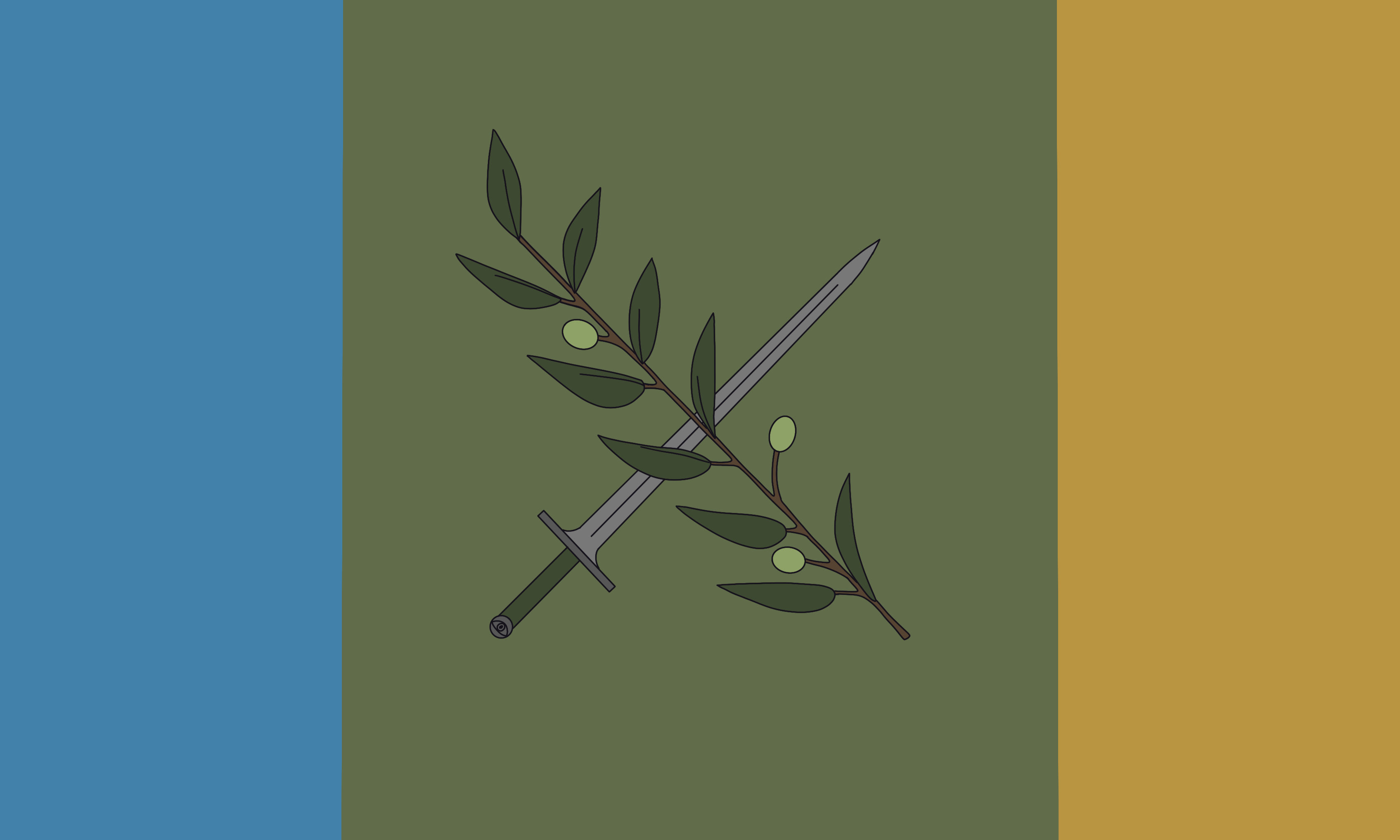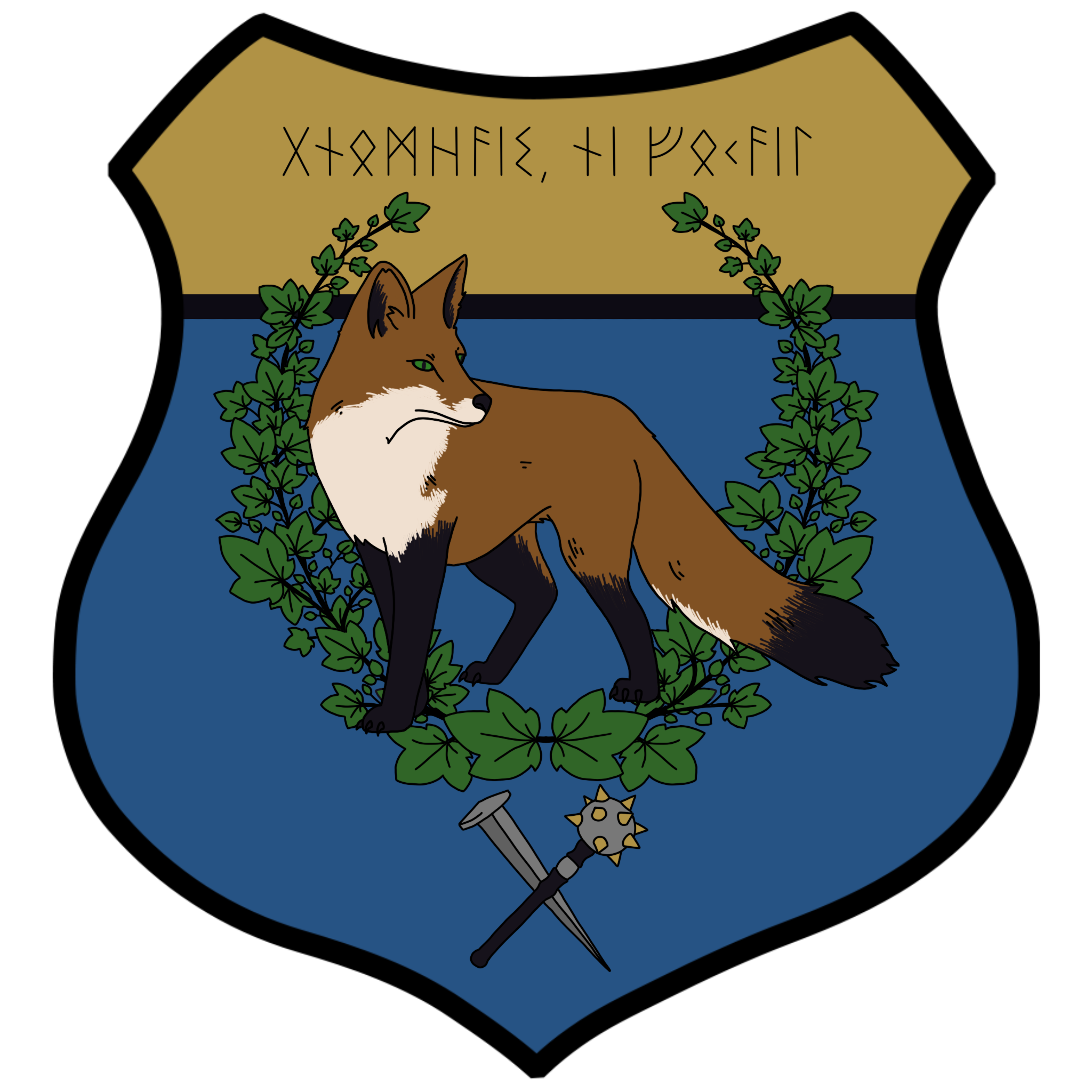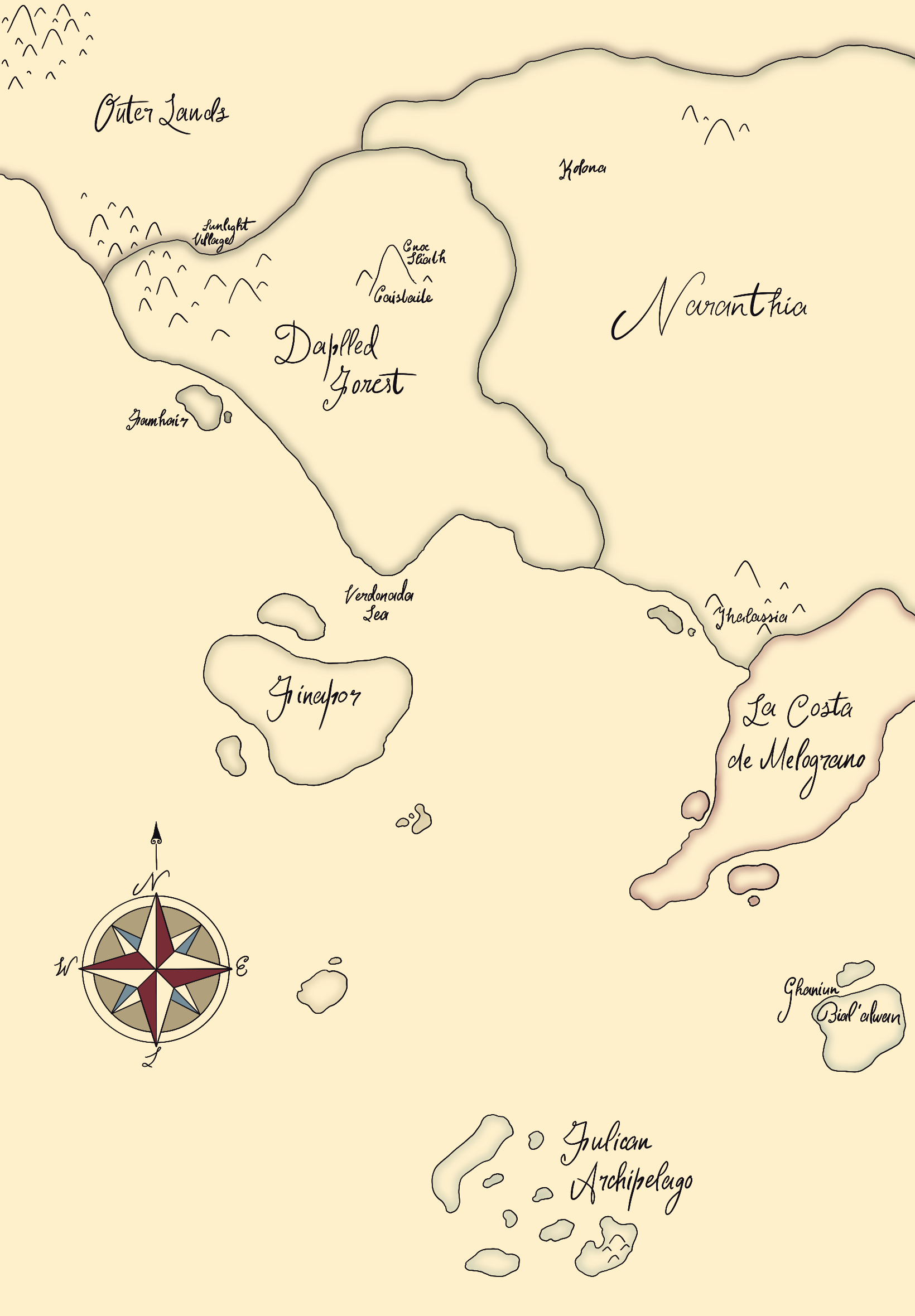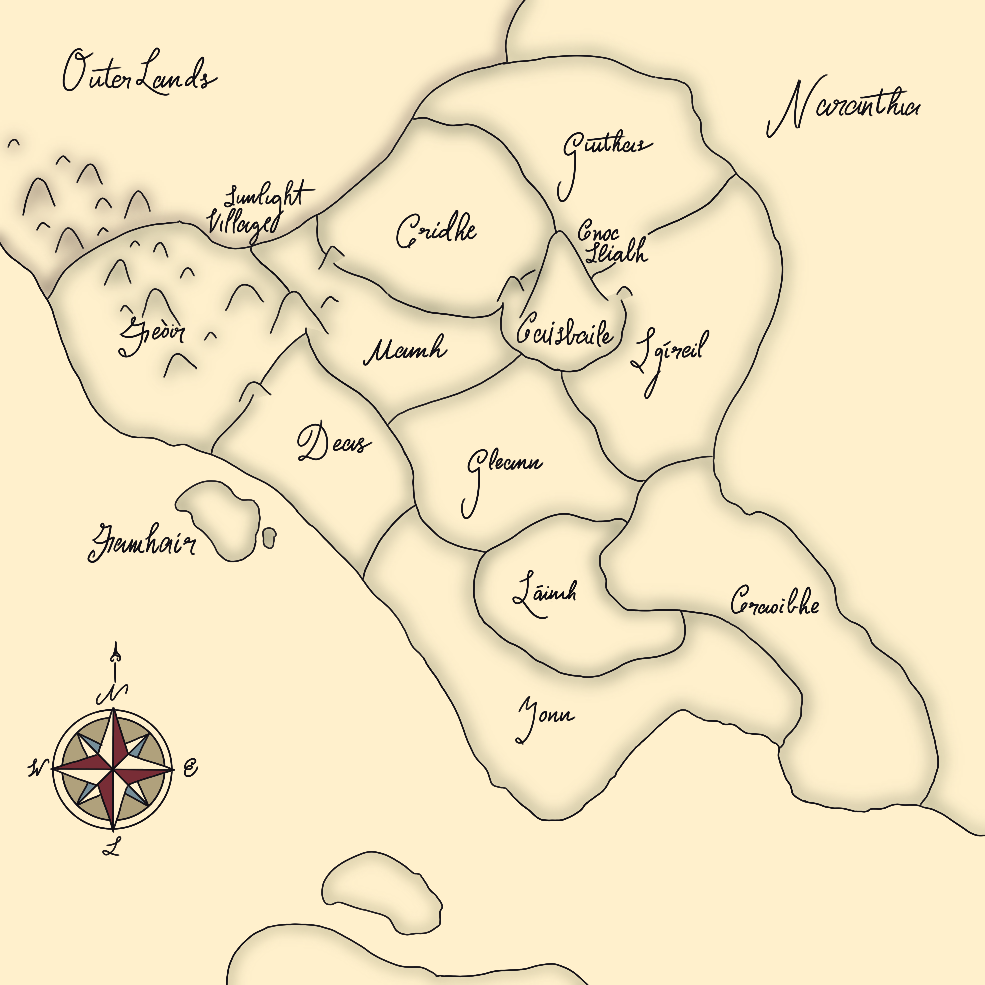The Flag

Ruler: Queen Chrysanthemum Aisling I of Clann Dune
Capital: Caisbaile
Official Languages: Foraoisteanga, Coillecànan
Other Languages: Common, Finaporean, Գաղտնիք (Gaghtnik), Bergeworten, Tafod
Currency: Dioscóir
History
🙚 Unitaithe 🙙
The Dappled Forest was originally a part of the kingdom of Unitaithe, which stretched across the forest, north to the Outer Lands, across the Verdonada Sea to present-day Finapor. The capital, Chéaville, was situated on the coast of the forested area, which allowed easy passage between the two sections of the kingdom.
Unlike the present day, the Seelie fae at this time had a good relationship with the neighboring kingdom of Naranthia, established in 404. The borders were open and trade was easy between the two kingdoms. The royal family of Unitaithe, the Elderberries, were well-known for their relationship with many noble elven families, marrying their own children into the aristocracy of Seelie fae and elven kingdoms alike.
In 723, King Persimmon Elderberry, who ruled Unitaithe at that time, died with no possible heir. The two heads of his government, the Royal Librarian, Guiscard Champignelle, and the Field Marshal, Sir Cillian Dune, began to argue over who would assume the title of King of Unitaithe, eventually declaring war on each other. The Five Years War, as it was called later, resulted in the splitting of the country into two parts. Guiscard Chamipgnelle and his family took control of the island of Finapor, while Sir Cillian Dune and his family took control of the Dappled Forest.
🙚 King Cillian 🙙
In 727, King Cillian Dune formally established the kingdom of the Dappled Forest. He chose the village at the base of Cnoc Sliabh, the Holy Mountain of Ceathodann, the religion of the Seelie fae, to be the new capitol, which he named Caisbaile. He began building a castle at the base of the mountain, carving parts of it directly into the cliffsides. There was much outcry from many members of the local temple, including their Shagart, a woman named Siobhan, who found it sacreligious to damage the Holy Mountain in such a way. However, threats made by the militaristic government that King Cillian had begun to form quickly silenced the resistance, and Sliabh Rook was finished in 738.
While considered a good ruler, King Cillian was well-known for his paranoia. Even before beginning to build his castle, he had ordered a wall be built along the border of his new kingdom, preventing any assailants from entering by land. He had an especially strong fear around invasion by Naranthian elves, and had extra security on the parts of the border shared with their country. This paranoia resulted in much misinformation being spread about the elves in the Dappled Forest, the effect of which can still be seen in the modern day.
Culture
🙚 Food 🙙
Due to cultural and religious beliefs about the sanctity of life, majority of Seelie fae in both Finapor and the Dappled Forest are vegetarian. Their staple crops are potatos, wheat, leeks, and beans. Meals are futher supplemented with cheese, butter, and other dairy products made with sheep, cow, or goat's milk, along with eggs and other animal products. Fish are also a common inclusion in dishes, though this is more common on the coasts, where pescatarianism is more popular.
Common cuisine varies between counties, though there is significant overlap. There is some external influence on cuisine from Finapor, as well as from Naranthia, but strict cultural preservation measures have mitigated these effects.
In the southern coastal counties of the Dappled Forest, specifically Feòir, Deas, Tonn, and the southern area of Craiobhe, the most common foods are fish cakes, seafood coddle and cullen skink (two types of fish stew), chowders, and cooked fish. The mountainous region spanning Uamh, Cridhe, and Giuthas has little agricultural capacity, and relies heavil on root vegetables for food. Common dishes, such as colcannon, are very often potato-based. The more verdant region in Gleann, Laimh, northern Craiobhe, and Sgíreil has the advantage of widespread agriculture and more diverse fruit and vegetable crops, along with access to more animal products than in the mountains. Colcannon is also popular here, along with neeps and tatties (a dish with turnip and potato), porridges, and vegetable pies.
🙚 Love 🙙
The ways in which a husband and wife meet, court, and marry varies based on social class. Royalty and nobility have stricter guidelines for who they are allowed to court and marry and the rules of courtship. The ways in which nobility and royalty meet potential romantic partners are strict and highly visible. The debut season is the most visible of ways in which a man meets eligible women and selects a future wife.
🙚 Religion - Ceathodann 🙙
The official religion of the Dappled Forest, Ceathodann, has been practiced in the area for centuries. It centers around a deity called the Goddess of Four Faces, or simply the Goddess, a woman who absorbed the soul of her three sisters after they died during a terribly cold Winter. The four sisters, or the Faces, are each said to represent one of the Seasons.
The Goddess also has a son, Laoghaire, who is the shepherd of Mag Mell, what Ceathodannians call their afterlife. He became the shepherd after the death of his beloved friend, Corwin, who became gravely ill one Winter and died shortly afterwards. Distraught, Laoghaire slit his own wrists so that he could go to Mag Mell, and never have to spend time apart from Corwin again. His own mother, the Goddess, was destroyed by her son’s decision, and, using her spellbook, found a way for Laoghaire to travel between Mag Mell and Tír na nÒg, the land of the living, so that she would not lose her son, and he would not lose his friend.
Ceathodannians celebrate a full calendar of holidays. The 8 principal holidays are called the Wheel of the Year, and mark specific dates indicating the passage of seasons, and the Seelie fae’s connection to nature. The Wheel of the Year is further split into the High Holidays, celebrated on the equinoxes and solstices, and said to be the time when the Goddess transitions from one Face to the next, and the Quarter Days, which celebrate specific events tied to the Season. Ceathodannians also celebrate the full moon with Moon Festivals, with specific rituals and offerings being left based on the time of year.
Ceathodannian temples are led by a Shagart, a person (usually female) who is trained in many of the magick arts, and is ordained to lead many different rituals pertaining to the different holidays, and to life in general.
🙚 Dying & The Dead 🙙
Dying in the Dappled Forest is considered sad, but not negative. Dying for any reason is seen as pre-ordained by the Goddess. The elderly and those with terminal illness are treated with the utmost respect and are often prioritized regardless of class or other placements in social hierarchies.
Society
🙚 Monarchy 🙙
The Dappled Forest is ruled by an absolute monarchy, where the ruler is decided based on bloodlines. In most cases, the eldest child is given the title of King or Queen upon the death of the current ruler, but there are examples of this not being the case, the most notable being:
Queen Aileen I (1238-1335)
During the First Elven War in 1256, increasing civil unrest became a threat to the Dappled Forest’s government. This unrest was furthered by the illness of King Conall, who most assumed would soon be traveling to Mag Mell for eternal rest. His son, Prince Alastair, was a fervent supporter of the war, and urged his father to abdicate so that he could take control of the military and defeat the elves. When King Conall died that year, it seemed that Prince Alastair would become king. However, his twin sister, Ailleen, convinced members of the court to have her crowned in her brother’s place, so that they might bring an end to the fighting. She succeeded, and was crowned the first Queen of the Dappled Forest in 1257.
King Eòghan (1655-1745)
The third son of Queen Isobel II and Prince Consort Lachlan, it was assumed that, after his eldest brother, Prince Baird, became king, Prince Eòghan would assume the title of Duke of Tonn, the southern region of the Dappled Forest, along the coast. Prince Baird was considered to be a just and kindly person, and so, when Queen Isobel II declared that Prince Eòghan would become king in the event of her death, it took many by surprise. It was after this that it was revealed that, while Prince Baird put on a good show for the people, he was not actually a very kind, or even very intelligent, person. To prevent her kingdom from falling into ruin in the hands of Prince Baird or his brother, the publicly cruel Prince Hamish, Queen Isobel II made the decision to have the young Prince Eòghan, only 15 at the time, made the Crown Prince. When she died in 1701, Crown Prince Eòghan was made King, and he ruled until his death, when his only son, Prince Fionn, was crowned.
Queen Chrysanthemum (1980-)
The second daughter of King Oisín and Queen Consort Virila, Princess Chrysanthemum was known for her lack of empathy for those around her. Like her elder sister, Princess Iris, it was well-known that she would not be made Crown Princess, with the title being destined to the youngest of King Oisín’s children, Prince Cedar. However, when Princess Chrysanthemum learned of this, she became enraged, thinking that the title of Queen was rightfully hers. Using her influence over the court, she manipulated those around her into overthrowing her father, deposing and banishing King Oisín and having Chrysanthemum made Queen in his place.
🙚 Local Government 🙙
The Dappled Forest is split into 10 Counties. While they are traditionally controlled by a Duke, any member of the aristocracy can be awarded control of a County by the King or Queen. They are assisted by a Lord-Lieutenant, as well as a Royal Guard Captain. A Scadán is also assigned by the Shagart to oversee the functioning of Ceathodannian temples in their County. The role of the Lord-Lieutenant is to advise the head of the County, and to represent them in the Royal Court if they are unable to attend. Royal Guard Captains are in charge of members of the Royal Guard assigned to their County. There is also a Royal Guard Captain assigned to Caisbaile (see the military section for more information).
- Feòir
- Seat:
- Lord-Lietenant
- Exports: Stone, dairy products (especially cheeses), textiles, leather
- Deas
- Seat:
- Lord-Lietenant
- Exports: Fruit wines, mead & ciders, textiles, honey, artwork, magick artifacts (Runes, charms, etc.)
- Tonn
- Seat:
- Lord-Lietenant
- Exports: Fish, lumber, malt extract, hard liquor
- Craoibhe
- Seat:
- Lord-Lietenant
- Exports: Stone, precious metals, gems, jewellery, lumber, magick artifacts (Runes, charms, etc.), artwork
- Láimh
- Seat:
- Duke Aonghus Campbell
- Lord-Lietenant Aodhán Ó Gamhna
- Exports: Textiles, dairy products (especially cheeses made from sheep's milk), produce
- Majority of Coillecànan speakers in the Dappled Forest live in Láimh.
- Gleann
- Seat:
- Baron Ellismere Devi
- Lord-Lietenant
- Exports: Textiles, artwork, lumber, dairy products (especially cheeses made from goat's milk)
- Uamh
- Seat: Chathair Verdi
- Lord Remis Verdi
- Lord-Lietenant
- Exports: Fruit wines, mead & ciders, hard liquor, stone, lumber, precious metals, gems
- Also home to the Acadamh Leighis Ríoga (Royal Medical Academy)
- Cridhe
- Seat:
- Duke Farlan Irving
- Lord-Lietenant
- Exports: Stone, precious metals, gems, lumber, jewellery
- Giuthas
- Seat: Bailobrach
- Duchess Boudicca Hywel
- Lord-Lietenant
- Exports: Stone, lumber, fruit wines, hard liquor
- Sgíreil
- Seat: Civetta
- Lord Oleander Viverra
- Lord-Lietenant
- Exports: Medicines, magick artifacts (Runes, charms, etc.), lumber, produce
🙚 Relationships with Other Countries and Kingdoms 🙙
Because of its strict customs laws and intense border restrictions, the Dappled Forest is not very diverse, with over 90% of the population being Seelie fae, majority of which were born within the kingdom. Another, smaller percent of these are immigrants from Finapor. There are is a small population of elves who live on the eastern border of the Dappled Forest, but the size of this group has been in sharp decline since the beginning of Queen Chrysanthemum's rule. Furthermore, due to her lax policy on the trapping of humans, the amount of humans living within the Dappled Forest has begun to grow in recent years, starting in 2003, when Queen Chrysanthemum obtained her first human pet.
Relations with the elf-ruled countries of La Costa De Melograno and Naranthia have long been strained by disputes between the Seelie fae and the elves. While these relations began to mend during the short rule of King Oisín, they have become worse since the coronation of Queen Chrysanthemum.
🙚 Social Structure 🙙
The Dappled Forest, while a monarchy, does have some social mobility, though not as much as contemporary kingdoms like Finapor and Naranthia. There are three distinct social ‘classes’ within the Dappled Forest, with subdivisions for different titles or roles within the community. The Royal Druid and their apprentices are considered to exist outside of this hierarchy. The current Royal Druid is Declan ó Broin.
Royal
- King / Queen: The ruler of the country. Maintains total power over the government, but often has advisors who assist in making decisions about laws or the government.
- Prince Consort / Queen Consort: The King or Queen's spouse. Holds some power within the government, but is usually relegated to maintaining the household. When their spouse dies, the Prince Consort or Queen Consort no longer has as much governmental power, and is moved below the Crown Prince or Crown Princess in the social hierarchy.
- Crown Prince / Crown Princess: The heir to the throne, and usually the eldest child. There are various examples of the Crown Prince or Crown Princess not being the eldest child, such as the case of King Eòghan, who was the youngest child in his family.
- Prince / Princess: All children of the King or Queen who are eligible for the throne. When one becomes the King or Queen, their siblings still hold their titles of Prince or Princess, but also assume the roles of the Dukes and Duchesses in specific areas of the country
Noble
- Duke / Duchess: Usually the Prince or Princess of a recent generation of the royal family, Dukes and Duchesses rule over the different sections of the country. In all, there are 10 Counties in the Dappled Forest, each with their own cities, towns, and villages, run by lower-ranking nobles.
- Count / Countess: The ruler of a city, they answer to the Duke or Duchess of their city's County. Most modern Counts and Countesses have mayors and other elected officials which handle the day-to-day troubles of large cities, but in the past the Count or Countess was in charge of all aspects of the city and surrounding areas.
- Baron / Baroness: The ruler of a small city or large town, they answer to the Duke or Duchess of the local County. Like Counts and Countesses, most modern Barons and Baronesses have elected officials do most of the work of running their city or town for them
- Lords / Ladies: Traditionally knighted, though often more likely to be the children of other noble families, Lords and Ladies usually rule over small towns, villages, or a personal estate. Like Counts and Countesses, as well as Barons and Baronesses, they answer to the ruler of their County. Because of the relatively small size of their lands, a Lord or Lady often doesn't need to organize an elected government in their area, though in small towns they might as a way of conforming to modern trends.
- Cloigeann: The head of all the Ceathodannian temples. While both the Dappled Forest and Finapor have Ceathodann as a practiced religion, the split between the two countries in 727 resulted in a rift in the religion. Currently, each country practices a distinct version of the religion, each with its own Cloigeann. After the death of the previous Cloigeann, a new one is selected by a board of Elders, usually older and experienced Scadán elected to the position by a vote from members of the clergy.
- Scadán: Proprieter of a specific section of temples within the Dappled Forest, and hand selected by the Coligeann and their board of Elders. The sections of temples have been divided and redivided over the centuries, but currently match the divisions of the Counties within the country, resulting in 10 current Scadán.
- Crann: Assistant to the Scadán, deals with a specific section of their division. Usually, a Crann will be assigned temples in one of the four cardinal directions, as if someone has taken a map of their division and drawn an X over it. This results in there being 4 to 8 Crann per County, based on the size of the area.
- Duilleog: Assistant to the Crann, does most of the actual in-person work at the temples. Often attends to larger ceremonies and rituals, especially Moon Festivals and High Holidays. The amount of Duilleog is based on the number of temples in a County, but they are usually assigned to attend to three or four temples each.
- Shagart: The head of the temple, though there are usually two or three Shagart in every temple, depending on its size. They do the daily prayers and smaller rituals, and assist the Duilleog during larger holidays.
- Manach: Assistants to both the Shagart and the Duilleog, they help with prayers, rituals, and ceremonies. They are usually the first point of contact when one has religious troubles, and they are more involved in their community than those higher up.
Common
- Merchants
- Farmers
- Tradesmen
- Poor
🙚 Military 🙙
The Royal Seelie Military of the Dappled Forest has three divisions dealing with different aspects of defense, as well as internal law enforcement.The Royal Guard and the Royal Seelie Army use the same naming structure for most of their ranks, though the Royal Guard only has 8 ranks, while the Royal Seelie Army has 19. The Royal Seelie Navy uses a different naming structure for their ranks. All three are shown below.
The Royal Guard
The smallest section of the Royal Seelie Military of the Dappled Forest, the Royal Guard is most concerned with border defense and law enforcement within the kingdom. Currently, the Royal Guard is led by Commandant Iian Campbell. There is one Captain for each of the 10 Counties of the Dappled Forest, as well as one charged with Caisbaile, the capitol. This captain is also responsible for the Prison Tree, located on the border between Caisbaile and Sgíreil.
- Feòir: Captain Taranis Gallchobhoir
- Deas: Captain Oscar Duinn
- Tonn: Captain Alpin Kelly
- Craiobhe: Captain Seamus Mac Cuinn
- Láimh: Captain Dáire Cathal
- Gleann: Captain Brian Armstrong
- Uamh: Captain Eoin Mac an Bhaird
- Cridhe: Captain Murray Ó Gamhna
- Giuthas: Captain Murdoch Young
- Sgíreil: Captain Fechin Barasho
Those in the Royal Guard are treated as lower-ranking than other members of the Royal Seelie Military. However, they're extremely important to the functioning of the Dappled Forest legal system. Any member of the Royal Guard at the rank of Inspector or below are tasked with the enforcement of laws within the kingdom, and are assigned to different precints based in the many different municipalities throughout each County. Inspectors are also tasked with investigating crimes which have been committed and bring perpetrators to justice.
The Royal Seelie Army
In charge of defending the Dappled Forest by land from other kingdoms, especially the elven kingdom of Naranthia, is currently led by General Blair Forbes. The RSA is the largest branch of the military, and has bases in the Dappled Forest, Finapor, and the Outer Lands, northwest of the kingdom.
The Royal Seelie Navy
The Royal Seelie Navy is in charge of defending the Dappled Forest by sea from other kingdoms, and is currently led by Admiral Islay Irving. The RSN has bases in each of the costal counties (Feòir, Deas, Tonn, and Craiobhe), as well as one base on the island of Famhair, just off the coast of Deas.
Ranks
Royal Guard
Royal Seelie Army
Royal Seelie Navy
Enlisted Ranks
Garda
Recruit
Seaman Recruit
Private, 2-wing
Ordinary Seaman
Private, 3-wing
Able Seaman
Corporal
Leading Seaman
Sergeant
Petty Officer
Inspector
Company Quartermaster Sergeant
Senior Petty Officer
Captain
Company Sergeant
Chief Petty Officer
Commandant
Regimental Quartermaster Sergeant
Senior Chief Petty Officer
Sergeant Major
Warrant Officer
Commissioned Officers
Second Lieutenant
Ensign
Lieutenant
Sub-lieutenant
Captain
Lieutenant
Commandant
Lieutenant Commander
Lieutenant Colonel
Commander
Colonel
Captain
Brigadier General
Commodore
Major General
Rear Admiral
Lieutenant General
Vice Admiral
General
Admiral


